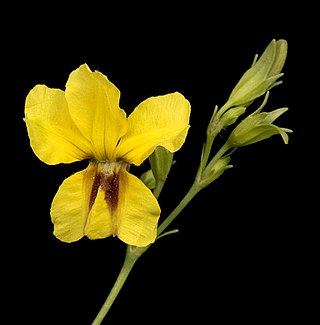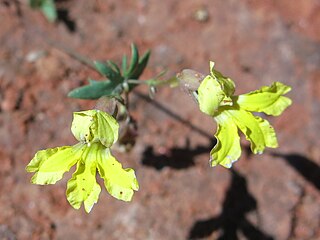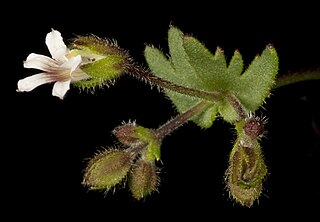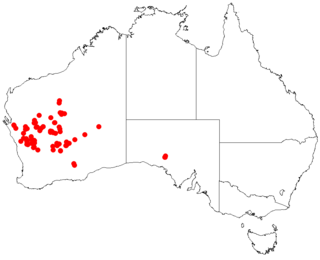
Goodenia montana, commonly known as mountain velleia, is a flowering plant in the family Goodeniaceae. It is a small, perennial herb with lance-shaped to egg-shaped leaves with the narrower end towards the base, and yellow flowers. It mainly grows in woodland and sub-alpine grasslands in New South Wales, Victoria and Tasmania.

Goodenia paradoxa, commonly known as spur velleia or spur goodenia, is a species of flowering plant in the family Goodeniaceae, and is endemic to Australia. It is a perennial herb covered with soft hairs, and has egg-shaped to elliptic leaves with toothed edges and yellow flowers on an ascending flowering stem.

Goodenia caroliniana is a species of flowering plant in the family Goodeniaceae, and is endemic to eastern Australia. It is a perennial herb with egg-shaped to lance-shaped leaves with toothed edges and the narrower end toward the base, and erect flowering stems up to 50 cm (20 in) high and yellow flowers.

Goodenia connata, commonly known as cup velleia, is a species of flowering plant in the family Goodeniaceae, and is found in all mainland states and territories of Australia. It is a glabrous annual herb with a rosette of leaves at the base, and ascending flowering stems with yellow, brownish-yellow or white flowers, often with mauve markings.

Goodenia macrophylla, or large-leaved velleia, is a species of flowering plant in the family Goodeniaceae, and is endemic to the south-west of Western Australia. It is a glabrous perennial plant with egg-shaped to elliptic leaves with toothed edges, and yellow flowers.

Goodenia glabrata, commonly known as pee the bed, is a species of flowering plant in the family Goodeniaceae and is native to mainland Australia. It is a mostly glabrous annual herb with ascending flowering stems, oblong to lance-shaped leaves with toothed edges, and yellow flowers.

Goodenia bellidifolia, commonly known as daisy goodenia, is a species of flowering plant in the family Goodeniaceae and is endemic to eastern Australia. It is an erect, perennial herb with egg-shaped to lance-shaped leaves with the narrower end towards the base, spikes or thyrses of lemon-yellow to orange flowers, and oval to more or less spherical fruit.

Goodenia cycnopotamica is a species of flowering plant in the Goodeniaceae family and is endemic to Australia, found in both South Australia and Western Australia. It is an annual herb with oblong to lance-shaped leaves and pink or lilac to white flowers.
Goodenia macroplectra is a species of flowering plant in the family Goodeniaceae and is endemic to inland Western Australia. It an erect herb with toothed, lance-shaped leaves at the base of the plant, and racemes of dark yellow flowers with a long spur.
Goodenia malvina is a species of flowering plant in the family Goodeniaceae and is endemic to north-western Australia. It is a prostrate to low-lying herb with egg-shaped to lance-shaped leaves on the stems and racemes of mauve to pinkish and yellowish flowers.
Goodenia megasepala is a species of flowering plant in the family Goodeniaceae and is endemic to Queensland. It is a prostrate to low-lying herb with toothed or lobed, lance-shaped to narrow elliptic leaves, and racemes of yellow flowers.

Goodenia mystrophylla is a flowering plant in the family Goodeniaceae and is native to eastern Australia and New Guinea. It is a small, perennial herb with lance-shaped leaves, prostrate or low-lying flower stems and yellow flowers with purplish markings.

Goodenia arguta, commonly known as spur velleia, or grassland goodenia, is a species of flowering plant in the family Goodeniaceae and endemic to continental Australia. It is a glabrous perennial with a rosette of leaves at the base of the plant and ascending flowering stems with deep yellow flowers.

Goodenia daviesii, commonly known as hairy velleia, is a species of flowering plant in the Goodeniaceae family and is endemic to inland areas of Western Australia. It is an annual herb with lyre-shaped, pinnatifid leaves and lilac to white flowers.

Goodenia discophora, commonly known as cabbage poison, is a species of flowering plant in the Goodeniaceae family and is endemic to the south-west of Western Australia. It is a herb with lyre-shaped, pinnatifid leaves and yellow flowers.

Goodenia brendannarum is a species of flowering plant in the family Goodeniaceae, and is endemic to a small area in the south-west of Western Australia. It is a perennial herb with woody stems, crowded, narrowly egg-shaped leaves with toothed edges, and erect flowering stems and orange-yellow and red flowers.

Goodenia capillosa, commonly known as hispid velleia, is a species of flowering plant in the family Goodeniaceae and is native to inland areas of Western Australia and South Australia. It is an annual herb with covered with soft hairs, and has narrowly egg-shaped to narrowly elliptic leaves with toothed or lyre-shaped edges, and yellow flowers.

Goodenia macrocalyx is a species of flowering plant in the family Goodeniaceae and is endemic to north-western Australia. It is a glabrous, perennial herb with elliptic to narrowly egg-shaped leaves at the base of the plant, yellow flowers and narrowly oval fruit.

Goodenia panduriformis, commonly known as Pindan poison, is a species of flowering plant in the family Goodeniaceae and is endemic to north-western Australia. It is a glaucous herb with erect flower stems, glabrous, toothed, egg-shaped leaves with the narrower end towards the base, bracteoles joined to form a large disc, and deep- or brownish-yellow flowers.

Goodenia perfoliata is a species of flowering plant in the family Goodeniaceae and is endemic to a small area of New South Wales. It is a mostly glabrous, perennial herb with erect flowering stems, lance-shaped leaves with sometimes deeply-toothed edges, and yellow flowers with bracteoles joined to form a disc-like funnel.

















